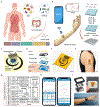A wearable electrochemical biosensor for the monitoring of metabolites and nutrients
- PMID: 35970928
- PMCID: PMC10432133
- DOI: 10.1038/s41551-022-00916-z
A wearable electrochemical biosensor for the monitoring of metabolites and nutrients
Abstract
Wearable non-invasive biosensors for the continuous monitoring of metabolites in sweat can detect a few analytes at sufficiently high concentrations, typically during vigorous exercise so as to generate sufficient quantity of the biofluid. Here we report the design and performance of a wearable electrochemical biosensor for the continuous analysis, in sweat during physical exercise and at rest, of trace levels of multiple metabolites and nutrients, including all essential amino acids and vitamins. The biosensor consists of graphene electrodes that can be repeatedly regenerated in situ, functionalized with metabolite-specific antibody-like molecularly imprinted polymers and redox-active reporter nanoparticles, and integrated with modules for iontophoresis-based sweat induction, microfluidic sweat sampling, signal processing and calibration, and wireless communication. In volunteers, the biosensor enabled the real-time monitoring of the intake of amino acids and their levels during physical exercise, as well as the assessment of the risk of metabolic syndrome (by correlating amino acid levels in serum and sweat). The monitoring of metabolites for the early identification of abnormal health conditions could facilitate applications in precision nutrition.
© 2022. The Author(s), under exclusive licence to Springer Nature Limited.
Conflict of interest statement
Competing interests
The authors declare no competing interests.
Figures





Similar articles
-
A Wearable Electrochemical Biosensor Utilizing Functionalized Ti3C2Tx MXene for the Real-Time Monitoring of Uric Acid Metabolite.Anal Chem. 2024 Mar 5;96(9):3914-3924. doi: 10.1021/acs.analchem.3c05672. Epub 2024 Feb 22. Anal Chem. 2024. PMID: 38387027
-
Computationally-assisted wearable system for continuous cortisol monitoring.Sci Bull (Beijing). 2025 Jun 30;70(12):2004-2013. doi: 10.1016/j.scib.2025.03.060. Epub 2025 Apr 17. Sci Bull (Beijing). 2025. PMID: 40328603
-
Universal Flexible Wearable Biosensors for Noninvasive Health Monitoring.ACS Appl Mater Interfaces. 2025 Apr 9;17(14):20741-20755. doi: 10.1021/acsami.4c22623. Epub 2025 Feb 27. ACS Appl Mater Interfaces. 2025. PMID: 40014807
-
Achievements and Challenges for Real-Time Sensing of Analytes in Sweat within Wearable Platforms.Acc Chem Res. 2019 Feb 19;52(2):297-306. doi: 10.1021/acs.accounts.8b00555. Epub 2019 Jan 28. Acc Chem Res. 2019. PMID: 30688433 Review.
-
Wearable biosensors for healthcare monitoring.Nat Biotechnol. 2019 Apr;37(4):389-406. doi: 10.1038/s41587-019-0045-y. Epub 2019 Feb 25. Nat Biotechnol. 2019. PMID: 30804534 Free PMC article. Review.
Cited by
-
Stretchable and Self-Healable Graphene-Polymer Conductive Composite for Wearable EMG Sensor.Polymers (Basel). 2022 Sep 8;14(18):3766. doi: 10.3390/polym14183766. Polymers (Basel). 2022. PMID: 36145910 Free PMC article.
-
Porous Laser-Scribed Graphene Electrodes Modified with Zwitterionic Moieties: A Strategy for Antibiofouling and Low-Impedance Interfaces.ACS Appl Mater Interfaces. 2024 Jan 31;16(4):4408-4419. doi: 10.1021/acsami.3c15849. Epub 2024 Jan 17. ACS Appl Mater Interfaces. 2024. PMID: 38231564 Free PMC article.
-
A Dual-Function Wearable Electrochemical Sensor for Uric Acid and Glucose Sensing in Sweat.Biosensors (Basel). 2023 Jan 6;13(1):105. doi: 10.3390/bios13010105. Biosensors (Basel). 2023. PMID: 36671938 Free PMC article.
-
Advances in field-effect biosensors towards point-of-use.Nanotechnology. 2023 Sep 25;34(49):492002. doi: 10.1088/1361-6528/acf3f0. Nanotechnology. 2023. PMID: 37625391 Free PMC article. Review.
-
Wearable sensors for telehealth based on emerging materials and nanoarchitectonics.Npj Flex Electron. 2023;7(1):26. doi: 10.1038/s41528-023-00261-4. Epub 2023 Jun 2. Npj Flex Electron. 2023. PMID: 37304907 Free PMC article. Review.
References
-
- Trumbo P, Schlicker S, Yates AA & Poos M Dietary reference intakes for energy, carbohydrate, fiber, fat, fatty acids, cholesterol, protein and amino acids. J. Am. Diet. Assoc 102, 1621–1630 (2002). - PubMed
-
- Wu G Amino acids: metabolism, functions, and nutrition. Amino Acids 37, 1–17 (2009). - PubMed

